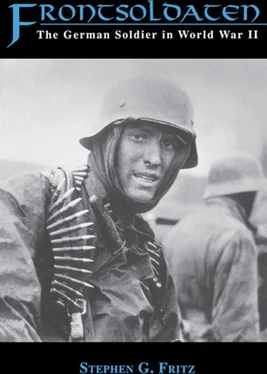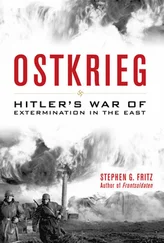“Where is he?” he shouted in a fury. “Where’s the other one?” In a few bounding steps he reached the… prisoner. Before anyone could do anything, he had run his knife into the belly of the petrified Russian. 45
“It isn’t easy to kill a man in cold blood,” Sajer concluded on another occasion, after having shot a partisan face to face, “unless one is entirely heartless or, as I was, numb with fear.” Indeed, it almost seemed that acts of cruelty performed in the midst of personal fury were necessary for one’s own well-being, to purge the constant fear and “refresh” oneself psychologically. Atrocities often took place under conditions of severe physical and psychological strain. After three days of nearly continuous battle during which they had witnessed scenes of unimaginable horror and brutality and had had virtually no sleep, Sajer and his group “were so exhausted that we stood up only when our fire had subdued the isolated and hopeless resistance from some entrenched hole,” he recollected.
Sometimes one or two prisoners might emerge from their hideout with their hands in the air, and each time the same tragedy repeated itself. Kraus killed four of them on the lieutenant’s orders; the Sudeten two; Group 17, nine. Young Lindberg, who had been in a state of panic ever since the beginning of the offensive, and who had been either weeping in terror or laughing in hope, took Kraus’s machine gun and shoved two Bolsheviks into a shell hole. The two wretched victims… kept imploring his mercy…. But Lindberg, in a paroxysm of uncontrollable rage, kept firing until they were quiet….
We were mad with harassment and exhaustion…. We were forbidden to take prisoners…. We knew that the Russians didn’t take any, …[that] it was either them or us, which is why my friend Hals and I threw grenades… at some Russians who were trying to wave a white flag.
Extreme exhaustion, the strain of seeing their friends killed, and simple fear all combined to cause young men to commit actions that under less trying circumstances would have revolted them. As the battle came to an end, Sajer admitted,
we began to grasp what had happened…. We tried to blot out the memory of the…. tanks driving heavily over that moving mass of human flesh…. We suddenly felt gripped by something horrible, which made our skins crawl…. For me, these memories produced a loss of physical sensation, almost as if my personality had split, …because I knew that such things don’t happen to young men who have led normal lives….
“We really were shits to kill those Popovs…,” [Hals said].
He was clearly desperately troubled by the same things that troubled me…. “[That’s] how it is, and all there is,” I answered…. Something hideous had entered our spirits, to remain and haunt us forever. 46
In this instance, human beings had responded to the overweening pressure of war with spontaneous acts of violence they later regretted. Almost certainly, however, the great majority of atrocities resulted from the ideological nature of the war in Russia, from deliberate action on the part of German authorities and their executioners, the ordinary men of the German police forces and army. In an order issued in May 1941, even before the German attack on the Soviet Union, Field Marshall Wilhelm Keitel, the titular head of the German armed forces (OKW), stressed that the upcoming campaign was to be a war against the Jews and Bolsheviks and that the Wehrmacht should move ruthlessly against these alleged enemies of Germany. To arouse the necessary ardor, he absolved soldiers from the jurisdiction of military courts if they should engage in atrocities against Russian civilians, and he approved measures of “collective reprisal.” As Christopher Browning has noted, the order amounted to a license to kill, a license that was renewed by the infamous Nacht und Nebel (Night and Fog) decree of December 1941, also issued by Keitel. 47
The average Landser, moreover, betrayed little sense of shock or outrage at such orders. The world was seething with death, and its proximity evidently stifled many a soldier’s compassion. War became a job, casual labor, common work, and whom or how one killed didn’t seem to make a great difference. Furthermore, the rank and file of the Wehrmacht were probably more thoroughly Nazified than has heretofore been acknowledged; indeed, average Landsers were consistently among Hitler’s strongest supporters. As a consequence, their letters and diaries disclose, there existed among the troops in Russia such a striking level of agreement with the Nazi regime’s view of the Bolshevik enemy and the sort of treatment that should be dealt them that many soldiers willingly participated in murderous actions. 48
“As a rule, the Russian prisoners were used to bury the dead,” noted Guy Sajer, “but it seemed they had taken to robbing the bodies…. In fact, I think the poor fellows… were probably going over the bodies for something to eat. The rations we gave them were absurd…. On some days, they were given nothing but water. Every prisoner caught robbing a German body was immediately shot. There were no official firing squads for these executions. An officer would simply shoot the offender on the spot.” This sort of casual cruelty was repeated endlessly throughout the vast expanse of Russia. “Once in winter,” remembered Max Landowski, “a [Russian] deserter came over. He was well clothed…. He had felt boots, …a Steppe coat, and a good fur hat. And as the deserter stood there, we began to take an interest in his things. Someone took the hat away from him, another pulled his boots off, a third needed his coat. In fact, the fellow finally stood there only in his underwear. Then the lieutenant said he should be taken back for interrogation…. A short time later there was a bang, and then the [German] came back. He reported, ‘Order carried out.’ He had shot him.” “We’re drawing ever closer to Moscow,” wrote Private H. in July 1941. “Everywhere there is the same picture of destruction…. All of whatever Commissars etc. [sic] are taken prisoner or grabbed are shot immediately. The Russians don’t do it any differently. A cruel war here.” 49Cruel indeed, but the noteworthy aspect was not the savagery of the war, but rather the commonplace attitude displayed by this soldier. “We take some prisoners, we shoot them, all in a day’s work”: this outlook recurred frequently in the Landsers’ correspondence, betraying an unspoken agreement with Nazi ideological goals.
“Someone has totally persuaded… the Russians that the Germans were slaughtering all prisoners,” Captain F.M. of the Seventy-third Infantry Division wrote incredulously, “and they also believed it.” But why shouldn’t the Russians believe it? After all, as Private A.V. admitted in a letter, “sometimes we also see someone who has been hanged. Those are people who have violated the property of the army or who hung around in the woods as partisans and committed terrorist actions. They remain hanging as a deterrent for two or three days.” The war against the partisans proved especially cruel, perhaps because it degenerated into a chaotic affair in which neither side respected the conventions of war. “The Feldwebel [sergeant] was staring at something in the ruins of the cabin,” Guy Sajer recalled of a nasty incident in the autumn of 1942.
We could see a man leaning against the wall. His face, half covered by a wild, shaggy beard, was turned toward us…. His clothes… were not a military uniform…. His left hand… was soaked with blood. More blood was running from his collar. I felt a twinge of unease for him. The Feldwebel ’s voice brought me back to reality.
“Partisan!” he shouted….“You know what you’re going to get…!” We carried the partisan outside…. The lieutenant looked at the bearded man, who was clearly dying. “Who’s this?”
Читать дальше












